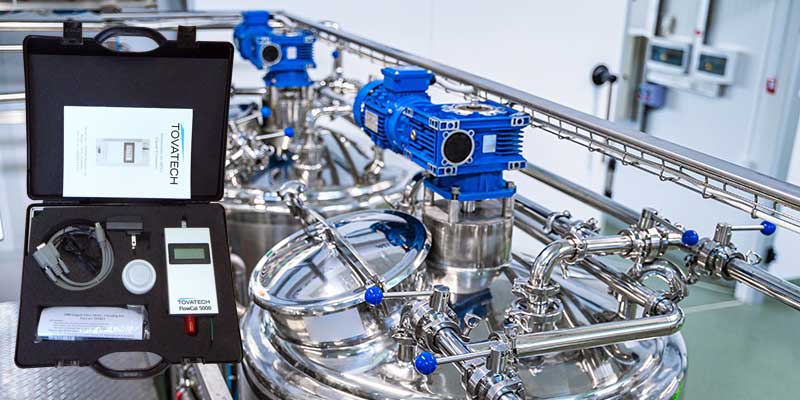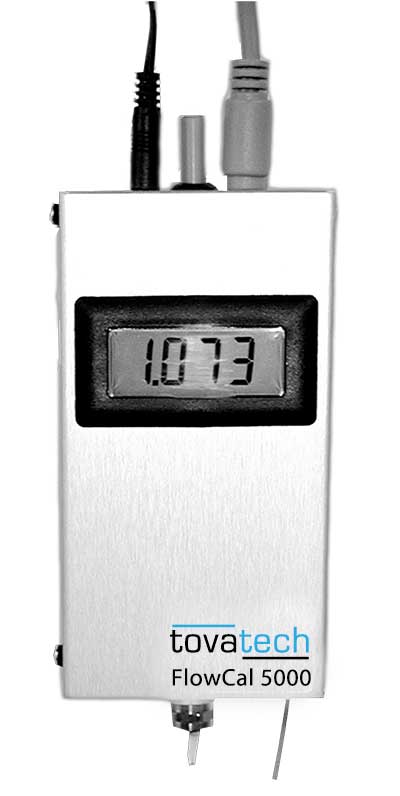
Digital HPLC Flowmeters – An Overview
What you’ll learn in this digital HPLC flowmeters overview:
- What flow meters do
- Flow measurement validation options
- HPLC flow meter calibration
- Mounting options for HPLC flow meters
- Connecting the flow meter to a PC
- How to maintain an HPLC flowmeter
- User testimonials

Flow meters come in many sizes and find application in a wide range of industries. As examples they meter gasoline pumped into your car and fuel oil into your heating system’s tank. But instead of metering in gallons (for example) digital HPLC Flowmeters measure small flow rates such as 0.05 to 25 milliliters (mL) per minute. This post provides an overview of lightweight, portable, and exceedingly accurate digital High Performance Liquid Chromatography (HPLC) flowmeters.
What HPLC Flow Meters Do
Among functions performed by HPLC are included checks for purity, monitoring changes in pharmaceutical intermediates during chemical synthesis scale-up, stability and dissolution tests, and performing ongoing quality control procedures.
Identifying an analyte by HPLC is based on accurate and reproducible column retention time as the analyte is pumped through an HPLC system. Reproducible retention time is critical and depends on accurate, uniform, reproducible HPLC pump flow rates.
A leak or other malfunction in the HPLC system will result in analysis errors. This means that HPLC systems should be regularly checked to ensure that the pump flow rate is properly calibrated. This is part of operational qualification (OQ) and is part of pump system validation.
OQ starts before the HPLC system is put into use and continues as part of ongoing system calibration checks.
These digital HPLC flowmeters are also used for ongoing installation, reinstallation, and performance qualification (IQ and PQ).
Learn more about this in our post A PDQ explanation of IQ, OQ and PQ.
Flow Measurement Validation Options
An FDA Group blog post notes “Newly installed or modified equipment must first be validated to determine if it’s capable of producing the desired results.”
This includes HPLC pump systems. And as with most techniques, there’s more than one way to accomplish a task. Here are examples.
Manual Methods for HPLC Pump System Validation
Manual methods for HPLC pump system validation are generally classified as volumetric or gravimetric measurement.
As the names suggest, one measures volume and requires the use of graduated cylinders; the other measures weight and requires the use of an analytical balance. Both require stop watches. Volumetric measurements call for a sharp eye to follow the moving meniscus.
Both are labor intensive, demanding concentration time and patience on the part of personnel performing the tests.
Labor intensity comes from having to repeat the method several times to collect sufficient data in order to calculate the standard deviation. A single measurement is insufficient to develop an accurate reading.
The length of time required for these tests depends on flow rate(s) being tested and the volume or weight being collected for the measurement.
As an example, if the flow rate is 1 ml/min it takes 5 minutes to collect 5 ml. Multiplying 5 minutes by the number of samples required to establish HPLC pump system flow rates give a good idea of the time required to complete the tests.
In a sentence, these methods, either volumetric or gravimetric, are tedious, time consuming and prone to operator error.
Another potential issue is sample evaporation during the collection procedure.
Digital HPLC Flow Meter Pump System Validation
In contrast, a portable digital liquid flow meter employs a single chip microcontroller and displays HPLC flow rates from 0.05 to 25 ml/min rounded to 4 digits.
The unit, called the Flow Cal 5000 is attached to the end of the HPLC system where the eluent is collected. Flow rates can be measured independently of liquid type. Accuracy is ±1% of the reading over the linear range.
Each new reading is presented on the unit’s liquid crystal display. Consistent readings indicate that the HPLC pump system is operating correctly.
According to a user an analysis can be completed in less than 5 minutes with no supervision and with superior accuracy and precision vs. manual methods. Furthermore, data can be transferred electronically to a printer or computer for record keeping.
Digital HPLC Flowmeter Calibration
Returning to our opening paragraph, gasoline pump flow meters at your local filling station and meters on fuel oil delivery trucks must conform to standards requiring periodic recalibration to certify you are getting the fuel you pay for.
In the same way, to assure the accuracy of a digital HPLC flowmeter initial and periodic recalibration is required.
Initial Flow Meter Certification
The FlowCal 5000 digital liquid flowmeter is shipped factory calibrated along with an accompanying calibration certificate for a flow rate of 1.0 ml/min plus additional flow rates requested by the customer. The calibration certificate certifies that the displayed flow rate is within ±1% of the actual flow rate at each calibration point.
Calibration points recorded on the result from an extensive process aimed at achieving statistically accurate data by taking, for example, 30+ readings at 0.5ml/min, 40+ readings at 1.0ml/min and ~100 readings at 5.0ml/min.
Data are captured and averaged via an RS 232 interface to a PC. The certificate shows the average of these readings at each flow rate. The percent error and percent standard deviation from the actual flow rates are also calculated from these averages and shown on the certificate.
The actual flow rate is determined gravimetrically, not with a reference flowmeter, but by collecting a mass of water passing through the flow meter over a recorded period of time.
Calibration equipment, the balance and counter timer are calibrated annually by an accredited certification lab. This provides traceability of measurement to recognized national standards.
Learn more about this in our post How to Read an HPLC Flow Meter Calibration Certificate.
HPLC Flow Meter Recalibration Processes
In accordance with GLP and to comply with other regulations, digital hplc flowmeters should be recalibrated annually. Recalibration procedures require returning the unit to the manufacturer and follow the same format used for initial calibration as described above.
The flow meter is first flushed with water. Then “as found” (or “before”) readings are taken at 1.0ml/min to measure the accuracy of the flow meter in the state in which it was received.
Customers may request that calibration certificates show “before” data at all the calibration points rather than exclusively at 1.0 ml/min.
The flow tube is cleaned, sensors are checked, any repairs undertaken, and necessary adjustments are made to bring the flow meter into specification. The flow meter is then calibrated to all the customer’s required flow rates.
“After” data are recorded on the calibration certificate to confirm that the returned flowmeter is performing according to specification.
For more info on this important topic see our post Calibrate a Flow Meter for HPLC Pumping Systems.
Mounting Options for HPLC Flowmeters

A flexible mounting system is a useful feature because it allows the flowmeter to be located in various sections of the plant. Several mounting options may be available, but all require that the meter be mounted within ~10 degrees of vertical. Here are options for the FlowCal 5000:
- It can be wall mounted using the supplied L brackets
- Using the base plate and feet it can be positioned on a work counter
- The stack-mounting option lets you place the unit to the left, right or in front of the pump and detection system
- A bottle top adaptor discharges into a reagent bottle
If a service company or a company’s service department maintains HPLC pumping systems at several locations, the FlowCal 5000 can be packed in a custom designed travel kit.
Connecting your FlowCal 5000 HPLC Flow Meter to a PC
Accurate HPLC flow rate records not only indicate GMP but are crucial when the FDA or other authorities come to call.
Digital liquid flow meters such as the FlowCal 5000 support FDA compliance for IQ, OQ and PQ validations in calibrating HPLC pump flow rates.
Connecting these meters to a PC with an RS-232 interface transfers flow meter readings into Excel via the Windows HyperTerminal program. It is a three-step process whereby data are collected and displayed using HyperTerminl.exe, copied on a clipboard and pasted into Excel for analysis.
Learn more on this topic in our post How to Connect your Flow Meter to a PC.
How to Maintain a Digital HPLC Flow Meter
While GLP requires yearly recalibrating your flowmeter, proper use and maintenance helps avoid degradation of your unit that can render it inaccurate and compromise fast, accurate calibration of HPLC pumping system flow rates.
Maintenance instructions are included in user manuals and cleaning kits shipped with the flowmeters. Here are some tips:
- Every two weeks clean meters in constant use in a process that should take about 15 minutes.
- Do not introduce two immiscible liquids into the flowmeter without either allowing the first to fully evaporate or by introducing a third solvent in which the others are miscible.
- A dirty sensing tube may trap bubbles and create falsely high readings. If bubbles are observed, a quick fix is to turn the unit off, wait approximately two seconds to allow it to drain, then switch it on. Regular use of the cleaning kit will avoid this problem. Do not disassemble the unit.
- To help prevent algae growth in the tube flush the flowmeter with ethanol if it will not be used for a week or more.
Learn more about HPLC maintenance in our post HPLC Flow Meter Cleaning Tips.
FlowCal 5000 User Testimonials
The benefits of the FlowCal 5000 are expressed in several user testimonials available on our website.
For additional information on the FlowCal 5000 liquid flow meter download our free definitive guide or contact the scientists at Tovatech.
